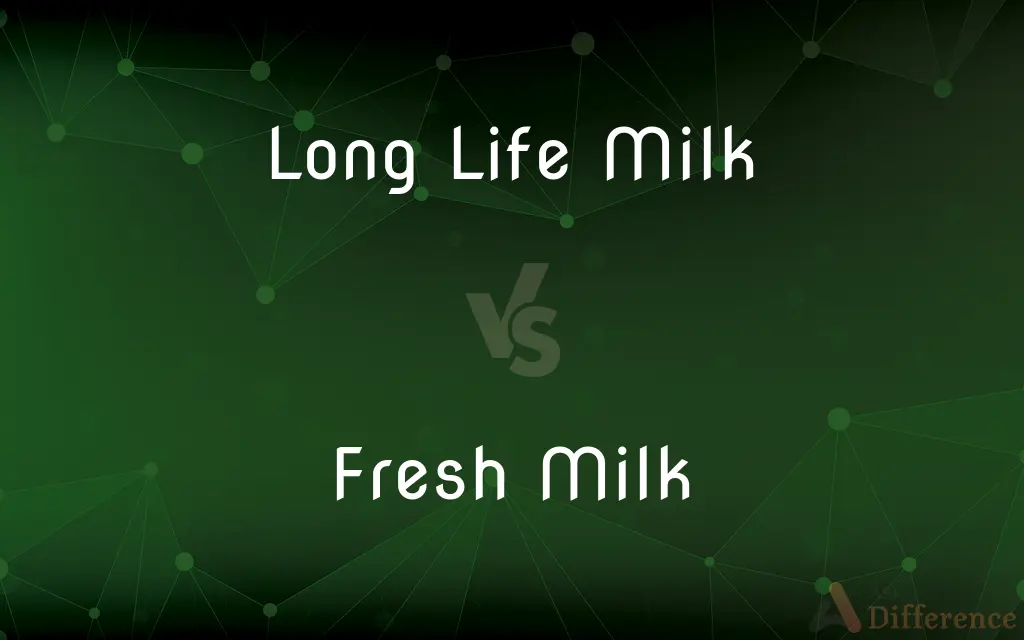Long Life Milk vs. Fresh Milk — What's the Difference?
By Tayyaba Rehman — Published on January 5, 2024
Long Life Milk undergoes ultra-heat treatment and airtight packaging for extended shelf life without refrigeration. Fresh Milk is pasteurized milk with a shorter shelf life, requiring refrigeration.

Difference Between Long Life Milk and Fresh Milk
Table of Contents
ADVERTISEMENT
Key Differences
Long Life Milk, also known as UHT (Ultra-High Temperature) milk, is processed through a high-temperature heating process (typically above 135°C) for a few seconds, killing bacteria and spores. This, combined with airtight packaging, allows it to be stored without refrigeration for months. Fresh Milk is pasteurized, heated to a lower temperature (around 72°C) for a short period, which kills harmful bacteria but requires refrigeration and has a shorter shelf life.
The taste and nutritional content can differ slightly between the two. Long Life Milk may have a slightly cooked taste due to the high-temperature processing, and some sensitive nutrients may be reduced. Fresh Milk generally retains a more traditional flavor and has a higher likelihood of preserving all its nutrients, although the differences are typically minor.
Long Life Milk is convenient for storage, especially in regions without reliable refrigeration, and for people needing a longer shelf life. Fresh Milk is often preferred for its fresh taste and is widely used where refrigeration is available and regular shopping is feasible.
In terms of packaging, Long Life Milk is often found in Tetra Pak or similar airtight containers to prevent contamination and preserve freshness. Fresh Milk is typically sold in plastic bottles or cartons and must be consumed within a week or so after opening.
The choice between Long Life Milk and Fresh Milk can depend on factors like storage options, preference in taste, and nutritional considerations. Both types of milk undergo safety checks and retain essential nutrients like calcium and protein.
ADVERTISEMENT
Comparison Chart
Processing Method
Ultra-High Temperature (UHT) treatment.
Pasteurization at a lower temperature.
Shelf Life
Months without refrigeration.
Short, requires refrigeration.
Taste
Slightly cooked taste.
Fresher, more traditional milk taste.
Nutritional Content
May lose some sensitive nutrients.
Retains most nutrients, but shorter shelf life.
Packaging
Airtight, sterile containers like Tetra Pak.
Plastic bottles or cartons, requires refrigeration.
Compare with Definitions
Long Life Milk
Does not require refrigeration until opened.
Long Life Milk is perfect for areas where refrigeration is limited.
Fresh Milk
Pasteurized milk requiring refrigeration.
Fresh Milk should be stored in the fridge immediately after purchase.
Long Life Milk
Packaged in aseptic containers to maintain sterility.
The Long Life Milk was stored in Tetra Paks for convenience.
Fresh Milk
Retains a traditional milk taste.
Many people prefer the taste of Fresh Milk for their daily use.
Long Life Milk
Ideal for emergency supplies due to its storage properties.
We included Long Life Milk in our emergency kit due to its long shelf life.
Fresh Milk
Popular for its fresh flavor and nutritional content.
Fresh Milk is a staple in our household for its fresh taste.
Long Life Milk
Often has a slightly different taste due to UHT processing.
She noticed that Long Life Milk tastes a bit different from fresh milk.
Fresh Milk
Has a shorter shelf life compared to UHT milk.
Make sure to consume the Fresh Milk within a week.
Long Life Milk
Milk treated at high temperatures for extended shelf life.
I stocked Long Life Milk for my camping trip due to its long shelf life.
Fresh Milk
Typically sold in plastic bottles or cartons.
She bought a carton of Fresh Milk for her morning coffee.
Common Curiosities
Does Fresh Milk have a different taste from Long Life Milk?
Yes, it often has a fresher taste.
What is Long Life Milk?
Milk treated at high temperatures to extend its shelf life.
What is Fresh Milk?
Milk that is pasteurized and requires refrigeration.
Is Long Life Milk safe to drink?
Yes, it's safe and undergoes rigorous safety checks.
Is Fresh Milk better than Long Life Milk?
It depends on personal preference and storage needs.
Does the process of making Long Life Milk affect its calcium content?
The calcium content is largely unaffected.
How long can Long Life Milk last?
Several months unopened without refrigeration.
What are the nutritional differences between the two?
They are similar, though some sensitive nutrients may be less in Long Life Milk.
Can I freeze Fresh Milk to extend its shelf life?
Yes, though it may slightly alter the texture.
Why choose Long Life Milk?
For its convenience and long shelf life without refrigeration.
How should Long Life Milk be stored after opening?
Refrigerate and consume within a few days.
Can Fresh Milk be stored without refrigeration?
No, it must be refrigerated.
Is Long Life Milk available in different fat contents?
Yes, it comes in various fat levels, similar to Fresh Milk.
Can Long Life Milk be used after its expiration date?
It's best to adhere to the expiration date for safety.
Which milk is better for cooking, Long Life or Fresh?
Both can be used, but Fresh Milk is often preferred for its taste.
Share Your Discovery

Previous Comparison
Geometric Mean vs. Arithmetic Mean
Next Comparison
Lip Balm vs. ChapstickAuthor Spotlight
Written by
Tayyaba RehmanTayyaba Rehman is a distinguished writer, currently serving as a primary contributor to askdifference.com. As a researcher in semantics and etymology, Tayyaba's passion for the complexity of languages and their distinctions has found a perfect home on the platform. Tayyaba delves into the intricacies of language, distinguishing between commonly confused words and phrases, thereby providing clarity for readers worldwide.
















































